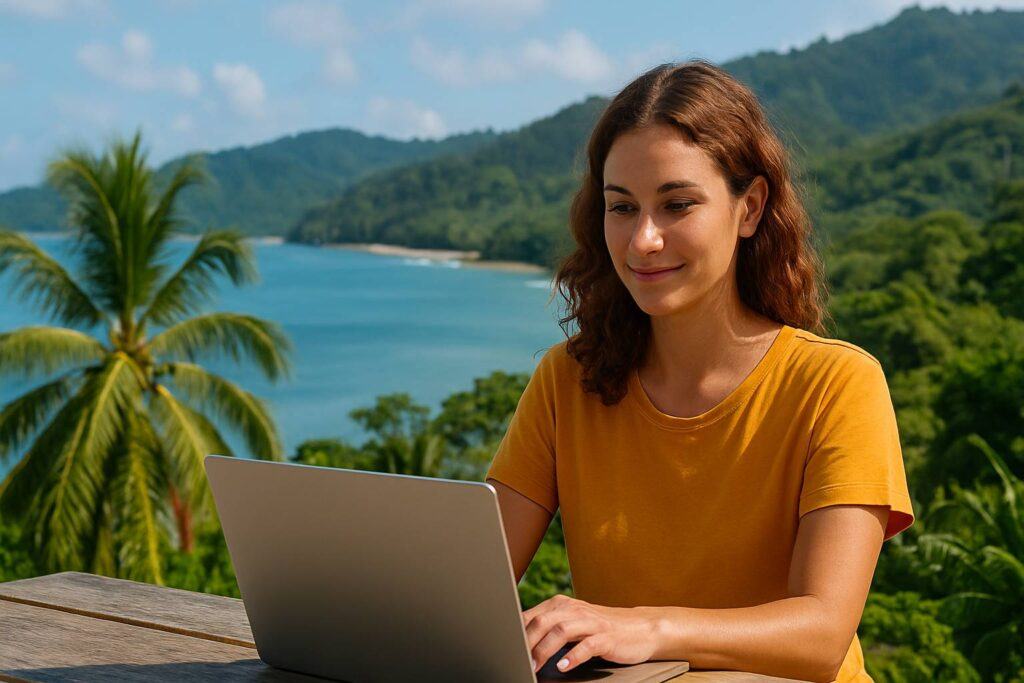Navigating Digital Nomad Visas: What You Need to Know doesn’t have to be overwhelming. Sure, the dream is working from a sunny café in Spain or catching the sunset after a Zoom call—but the reality of visas can feel like a maze of rules, fees, and fine print.
I’ve been there myself, scrolling through country websites and second-guessing what I really needed. That’s why I created this guide: to strip away the confusion and give you the essentials in plain English.
By the end, you’ll know what digital nomad visas are, who qualifies, how much they cost, and which destinations are worth your time—so you can focus less on paperwork and more on planning your adventure.
What Do You Need to Know to Get Your Digital Nomad Visa?
Getting your Digital Nomad Visa doesn’t have to be stressful! Here’s what helps things go smoothly: know what the visa is, check if you qualify, figure out your costs, pick a destination and how long you want to stay, and watch out for common pitfalls like delays. If you keep your documents organized before you hit that Apply button, you’ll be ahead of the game.
Step 1: So, What Exactly Is a Digital Nomad Visa?
Digital nomad visas (a type of residency permit) came about in response to the remote work boom and the growing desire to live somewhere new for an extended period. These visas let you live legally in another country while working remotely, without taking up local employment. Unlike a tourist visa, which usually limits you to 30–90 days and doesn’t officially allow remote work, a digital nomad visa covers you for longer stays.
The host country benefits when you purchase their local goods and services.
👉 Back when I first started traveling, I had to rely on tourist visas. I was constantly watching the calendar to make sure I didn’t overstay. It was stressful! These new nomad visas are such a game-changer because they give you peace of mind to settle in and really live somewhere.
Step 2: Let’s See If You Qualify
Most countries want proof that you can support yourself and won’t compete for local jobs. Here’s what you’ll almost always need:
- Proof of remote income (contracts, pay slips, freelance agreements, or bank statements).
- Minimum monthly income, typically $1,500–$5,000 USD.
- International health insurance to cover your medical and dental expenses for your entire stay.
- A valid passport (6–12 months beyond your planned stay).
- Proof showing that you will not be a permanent resident at the end of your visit.
- Background check (sometimes optional, sometimes required).
- You might have to provide proof of your accommodation, which can be a rental agreement.
Once you gather all your documents, follow the application instructions from the host country and submit them online or through the consulate. Wait to hear back from them.
👉 I remember my first attempt at pulling together proof of income for a visa—I had client payments scattered across PayPal, bank transfers, and invoices. It took me hours to piece it all together. Since then, I’ve kept a neat folder with everything in one place. Trust me, getting organized early makes the whole process easier.
Step 3: Let’s Talk About the Costs (They Add Up Fast!)
The costs vary depending on the country you are travelling to.
- Application fees: $100 to $2,500+ (non-refundable)
- Document prep: Notarized translations, apostilles, background checks
- Health insurance: More comprehensive than basic travel coverage
- Banking fees: Statements, transfers, or exchange rates
- Taxes: if you stay more than 183 days, you may owe local taxes
Of course, you still have to add in your day-to-day living expenses and accommodation.
👉 When I applied for a visa in Central America, I thought the biggest expense would be the official fee. But what really surprised me were the “extras”—apostilles for my background check, multiple document translations, and even courier fees. By the time I was done, the add-ons had nearly doubled my original budget. Lesson learned: always pad your budget for the hidden stuff.
Step 4: How Long Do You Actually Want to Stay?
Most visas last six months to a year, but some (like Portugal or Greece) stretch to two years or allow renewals. In some cases, staying long enough opens the door to residency. Costa Rica, for example, offers a 12-month visa renewable for another year.
✨ Personal Note: My Time in Turks & Caicos
When I lived in Grand Turk for over four years, what began as a short stay quickly turned into real life. Since there wasn’t a digital nomad visa, I took a different route. I purchased a house and worked at a local dive shop with a sponsored work permit. It worked, but it was far more complicated (and costly) than the streamlined digital nomad visas available today. Honestly, I often wished Turks & Caicos had a proper nomad visa—it would have made the whole process so much easier.
Step 5: Where in the World Can You Go?

Here are some popular regions and their programs:
- Caribbean: Barbados (Welcome Stamp), Antigua & Barbuda (Nomad Digital Residence), Dominica (Work in Nature)
- Latin America: Costa Rica, Panama, Colombia, Brazil
- Southeast Asia: Thailand (Long-Term Resident), Malaysia (DE Rantau), Indonesia (Second Home Visa / digital nomad option in progress), Philippines (new 2024 visa)
- Africa & Indian Ocean: Mauritius (Premium Visa), Seychelles (Workcation), Cape Verde (Remote Working Program), South Africa (new digital nomad visa)
👉 The Caribbean will always have my heart—I’ve lived and worked on islands where I’d spend mornings at my laptop and afternoons snorkeling in turquoise waters. That’s the beauty of these visas: you get to blend real life with a lifestyle that feels like a dream.
Step 6: Watch Out for the Sneaky Pitfalls
Getting a digital nomad visa might sound straightforward on paper, but in reality, there are often bumps along the way. Governments can update rules without notice, paperwork can drag on for months, and small details—like how you prove income—can suddenly become big hurdles. It’s not about scaring you off, but about being prepared so your dream move abroad doesn’t get tripped up by avoidable surprises.
- Processing times vary—weeks in some places, months in others.
- Programs can change suddenly (The Bahamas paused theirs in 2023).
- Staying over six months may trigger tax residency.
- Proof-of-income requirements can be strict (freelancers may need extra paperwork).
👉 A friend of mine applied for a visa in Europe and nearly booked her flights before the approval came through. It ended up taking three months! That taught me to never lock in travel plans until the visa is officially stamped.
Step 7: Pick the Place That Fits Your Lifestyle
Choosing the right visa is only half the battle. Choosing the right place is what really makes or breaks your experience. Beyond the paperwork, your day-to-day happiness depends on things like time zones, internet reliability, and whether the local lifestyle is a match to your own rhythm. What looks like paradise on Instagram might not always work in real life, so weigh-in the practical factors alongside your dreamy views.
This choice shapes your daily life, not just your paperwork. Consider:
- Time zones: Will you be taking midnight client calls?
- Internet & infrastructure: WiFi quality isn’t guaranteed everywhere.
- Cost of living vs. income requirements: Balance what you earn with what you’ll spend.
- Safety, community, climate: Important for feeling at home long-term
- Healthcare & regional travel options: Easy access makes a big difference
👉 I once stayed in a gorgeous beach town that looked like paradise in photos—but the WiFi crashed every afternoon right when I had client calls. Frustrating! As much as I loved the sunsets, it wasn’t workable for the long term. That experience taught me that the “boring” details, like infrastructure, matter just as much as scenery when you’re choosing where to live.
Step 8: Gather Your Stuff and Hit “Apply”
Once you’ve picked your destination, it’s time to get your paperwork in order. This part isn’t glamorous, but being organized here saves you stress later. Think of it like packing for a trip—you wouldn’t show up at the airport without your passport, and you don’t want to hit “submit” on a visa application missing a crucial document. A little preparation up front means a smoother, faster approval process.
Here’s what to have ready:
- Valid passport (6–12 months left before expiry)
- Proof of income (bank records, contracts, or pay slips)
- Health insurance certificate
- Background check (sometimes translated/apostilled)
- Housing or rental details (if required)
- Completed application + payment receipt
- Both digital and paper copies of everything
👉 Before I submit anything, I always make two sets of copies—digital and paper. Once, I had to show the same document three different times during an application process. Having spares on hand saved me from a lot of stress.
🔥 Top Questions (and Straight Answers)
Q: How fast will my digital nomad visa get approved?
A: It depends. Barbados is quick (sometimes under two weeks), while Costa Rica or Portugal may take months. Always check official timelines before booking your travel.
Q: Can I bring my family with me?
A: Usually, yes—but you’ll need higher income proof. Some countries let you add dependents to your visa; others make them apply separately.
Q: What if I want to stay longer than my visa allows?
A: Some visas are renewable (Costa Rica offers two years total), while others are not. Research renewal rules before you apply, or be ready to switch visas or move to a nearby country.
✅ Your Digital Nomad Prep Checklist
- Pick your destination and decide how long you want to stay.
- Check to make sure you meet the main requirements for your chosen country.
- Organize your finances, insurance, and application documents ahead of time.
- Monitor updates to visa programs through government sites and nomad forums.
- Once approved, pack your bags and soak up the journey!
✨ Bringing It All Together
At the end of the day, digital nomad visas aren’t just about ticking boxes—they’re about freedom, choice, and creating a lifestyle you don’t need a vacation from. You now have the essentials: the steps, the pitfalls to avoid, and the prep list to keep you on track
👉 So, what’s stopping you? Start exploring your options, gather your documents, and take that first leap. Your next adventure—and your new “office”—is waiting for you.
Have you had digital nomad visas before? How did it go?
Thanks for reading! I hope this was helpful information. If you have any questions, please enter them in the Comment Box below and I will respond back.
Monica


